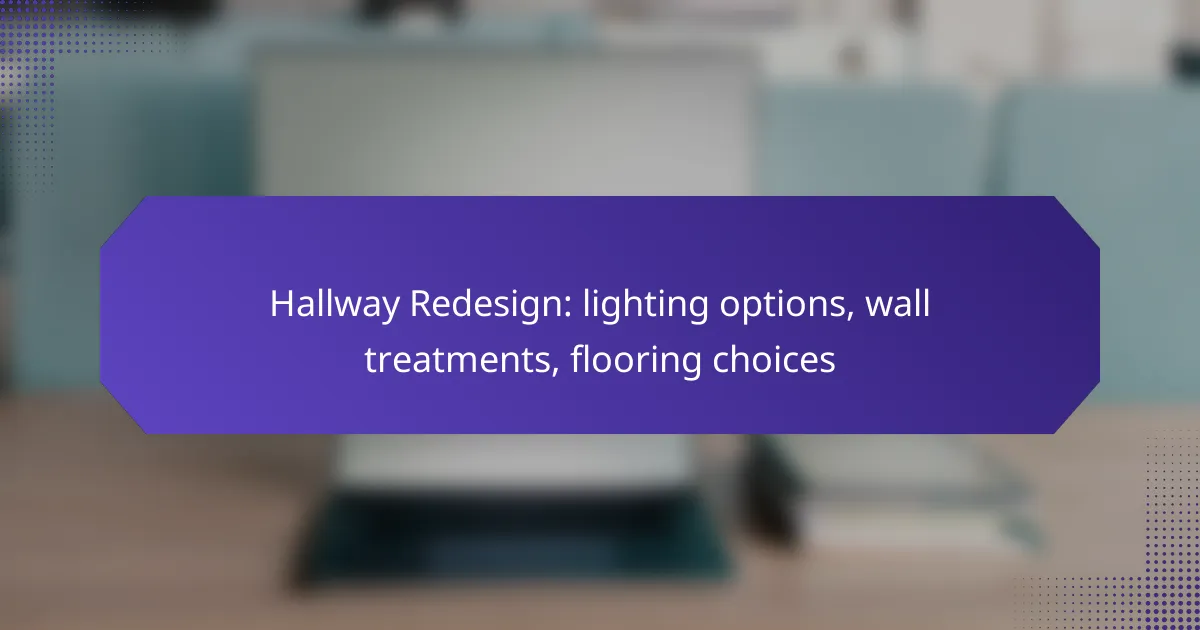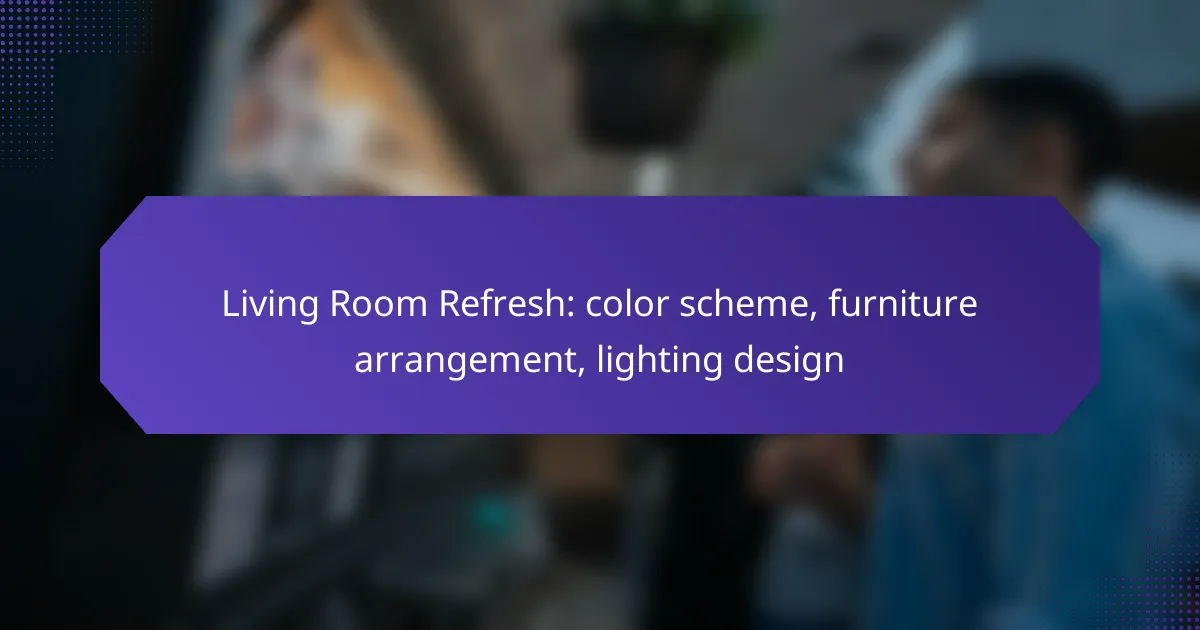Redesigning a hallway can transform it into a welcoming and functional space. By carefully selecting lighting options, wall treatments, and flooring choices, you can enhance both the aesthetic appeal and practicality of the area. From LED recessed lighting to durable flooring materials, each element plays a crucial role in creating a cohesive and inviting environment.

What are the best lighting options for hallway redesign?
The best lighting options for hallway redesign include LED recessed lighting, wall sconces, smart lighting systems, track lighting, and pendant lights. Each option offers unique benefits and can enhance both functionality and aesthetics in your hallway.
LED recessed lighting
LED recessed lighting is a popular choice for hallways due to its sleek appearance and energy efficiency. These fixtures are installed into the ceiling, providing a clean look while illuminating the space without taking up visual real estate.
When selecting LED recessed lights, consider the brightness (measured in lumens) and the color temperature (measured in Kelvin) to create the desired ambiance. A range of 2700K to 3000K is often ideal for warm, inviting light.
Wall sconces
Wall sconces add both style and functionality to hallways, providing ambient lighting while enhancing decor. They can be placed at eye level or higher to create a layered lighting effect.
Choose sconces that complement your hallway’s design theme. For narrow spaces, opt for slim-profile sconces that won’t protrude too much and create obstructions.
Smart lighting systems
Smart lighting systems allow for customizable lighting control, enabling you to adjust brightness and color remotely via smartphone apps or voice commands. This flexibility is particularly useful in hallways where lighting needs may vary throughout the day.
When implementing smart lighting, ensure compatibility with your existing fixtures and consider systems that offer scheduling features for added convenience and energy savings.
Track lighting
Track lighting is versatile and adjustable, making it suitable for hallways with varying widths and lengths. This system consists of a mounted track with movable light fixtures that can be directed to highlight artwork or architectural features.
Consider the layout of your hallway when installing track lighting to ensure even illumination. It’s also beneficial to choose LED bulbs for energy efficiency and longevity.
Pendant lights
Pendant lights can serve as a stylish focal point in a hallway, especially in spaces with high ceilings. They provide direct lighting and can enhance the overall design aesthetic.
When selecting pendant lights, consider the height of the ceiling and the scale of the fixture. Aim for a height that allows for safe passage while maintaining visual appeal.

How to choose wall treatments for hallways?
Choosing wall treatments for hallways involves considering aesthetics, durability, and maintenance. Options like paint, wallpaper, wood paneling, and textured finishes each offer unique benefits and can significantly impact the overall look and feel of the space.
Paint finishes
Paint finishes can dramatically alter the appearance of a hallway. Common options include matte, eggshell, satin, and gloss, each providing different levels of sheen and durability. For high-traffic areas, satin or semi-gloss finishes are often recommended due to their washability and resistance to scuffs.
When selecting a color, lighter shades can make a narrow hallway feel more spacious, while darker hues can create a cozy, intimate atmosphere. Consider using a color that complements the adjacent rooms for a cohesive look.
Wallpaper designs
Wallpaper offers an array of designs, patterns, and textures that can enhance a hallway’s character. From bold prints to subtle textures, the choice of wallpaper can set the tone for the entire home. Peel-and-stick options are particularly popular for hallways due to their ease of application and removal.
When choosing wallpaper, consider the hallway’s lighting and size. Light-colored wallpapers can brighten up a dim space, while intricate patterns can add visual interest but may overwhelm a small area.
Wood paneling
Wood paneling adds warmth and a touch of elegance to hallways. It can be installed in various styles, including shiplap, beadboard, or traditional raised panels. The choice of wood type, such as oak or pine, will affect both the look and durability of the paneling.
For maintenance, consider using treated wood or applying a protective finish to prevent wear and tear. Wood paneling can also be painted or stained to match your desired aesthetic, providing versatility in design.
Textured finishes
Textured finishes, such as stucco or plaster, can create a unique visual effect in hallways. These finishes can add depth and interest, making plain walls more dynamic. They are often used in modern or rustic designs to enhance the overall ambiance.
When opting for textured finishes, consider the level of maintenance required. Some textures may require more frequent cleaning or touch-ups, so weigh the aesthetic benefits against practical upkeep. Additionally, ensure that the texture complements other design elements in your home for a harmonious look.

What flooring choices are ideal for hallways?
When selecting flooring for hallways, durability, maintenance, and aesthetics are key factors. Ideal options include hardwood, laminate, vinyl planks, and tile, each offering distinct advantages and considerations for high-traffic areas.
Hardwood flooring
Hardwood flooring is a classic choice that adds warmth and elegance to hallways. It is known for its durability and can last for decades with proper care. However, it may require refinishing over time and can be susceptible to scratches and moisture damage.
Consider using hardwood with a high Janka hardness rating for better resistance to wear. Popular species like oak and maple are often recommended for their strength and beauty.
Laminate flooring
Laminate flooring mimics the appearance of hardwood but is more affordable and easier to maintain. It consists of a high-density fiberboard core topped with a photographic layer that resembles wood or stone.
This option is highly resistant to scratches and fading, making it suitable for busy hallways. Look for laminate with a thick wear layer for added durability, and ensure it has a moisture-resistant backing if your hallway is prone to spills.
Vinyl planks
Vinyl planks are versatile and water-resistant, making them an excellent choice for hallways that may experience moisture. They come in various styles, including those that closely resemble natural wood or stone.
Installation is typically straightforward, and many options feature a click-lock design for easy DIY projects. Choose thicker planks for better comfort underfoot and sound absorption, especially in multi-story homes.
Tile options
Tile flooring is a durable and stylish option for hallways, available in materials like ceramic, porcelain, and natural stone. It is highly resistant to moisture and stains, making it ideal for areas with heavy foot traffic.
Consider slip-resistant tiles for safety, especially in homes with children or elderly residents. While tile can be cold underfoot, adding area rugs can enhance comfort and style while protecting the floor.

What factors to consider when redesigning a hallway?
When redesigning a hallway, key factors include space dimensions and traffic flow. These elements influence design choices such as lighting, wall treatments, and flooring, ensuring functionality and aesthetic appeal.
Space dimensions
Understanding the space dimensions of your hallway is crucial for effective redesign. Measure the length, width, and height to determine how much room you have for lighting fixtures, wall treatments, and flooring options. A narrow hallway may benefit from lighter colors and vertical lighting to create an illusion of space.
Consider the proportions of furniture and decor as well. For example, if the hallway is less than 1 meter wide, avoid bulky furniture or decor that could obstruct movement. Instead, opt for slim console tables or wall-mounted shelves to maximize usability.
Traffic flow
Traffic flow refers to how people move through the hallway and is essential for a functional design. Assess the frequency of use and the typical direction of movement. High-traffic areas may require durable flooring materials, such as tile or hardwood, that can withstand wear and tear.
Ensure that the design does not create bottlenecks. For instance, if the hallway connects multiple rooms, avoid placing obstacles like large plants or furniture that could impede movement. Instead, keep pathways clear and consider using wall-mounted lighting to avoid taking up floor space.










